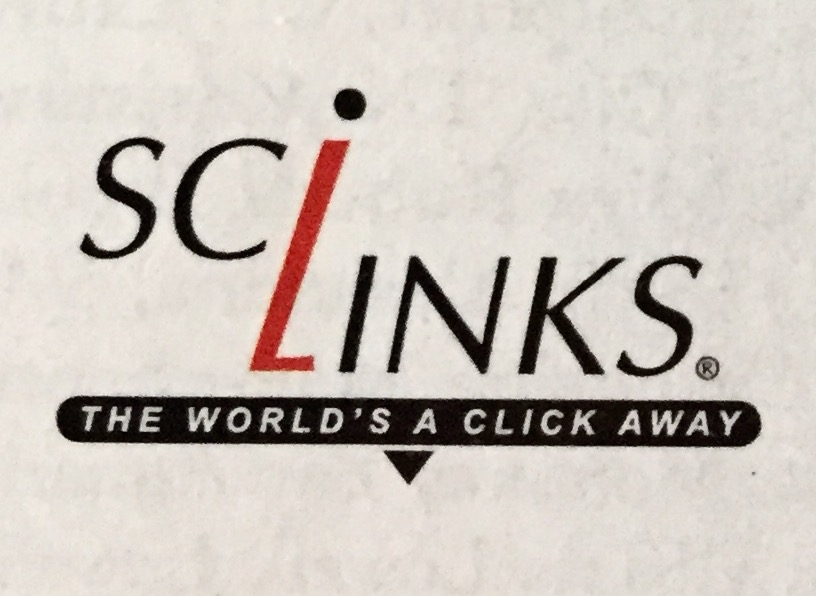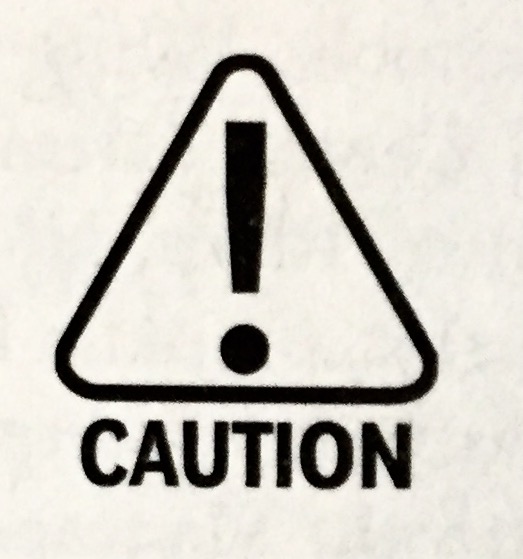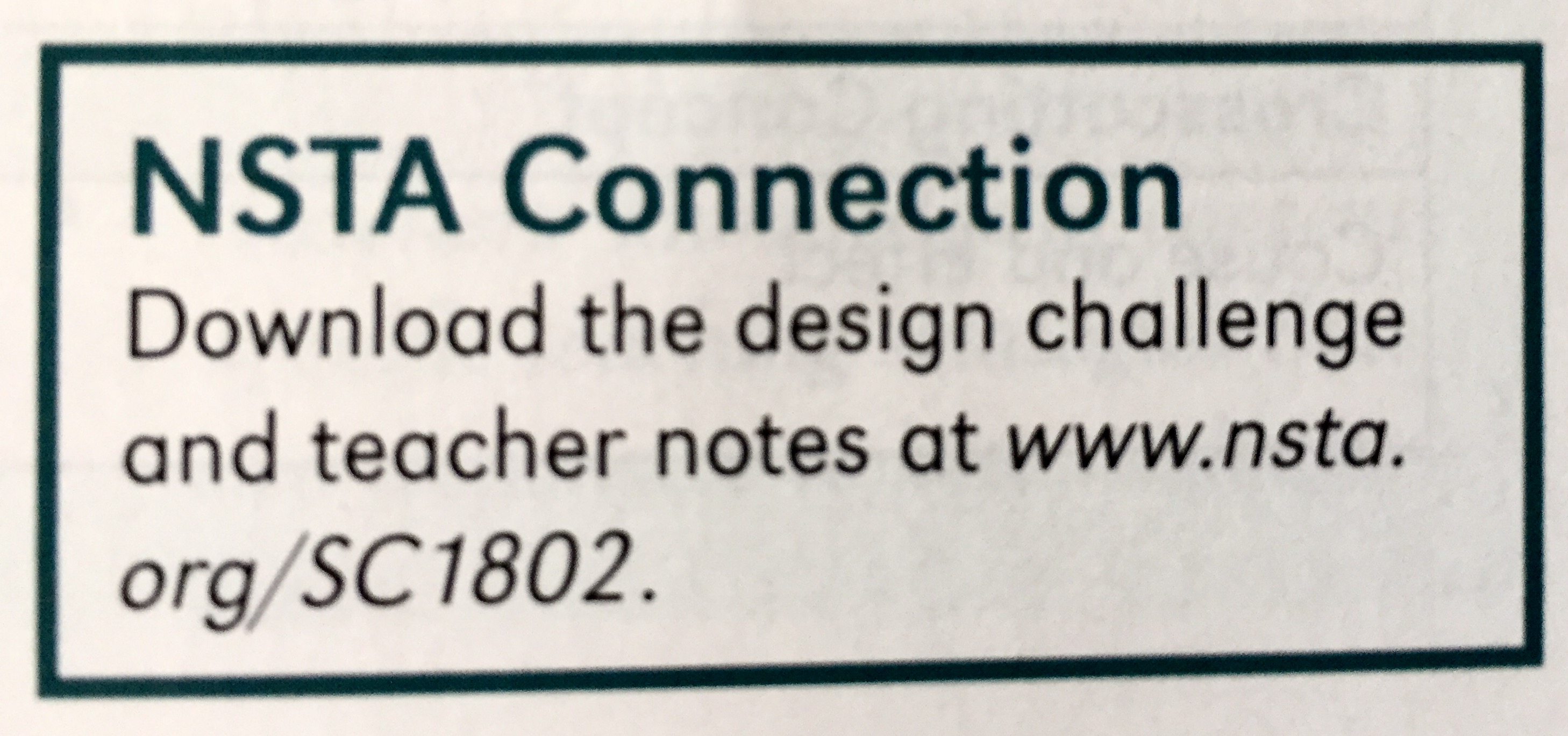Ed News: Using Science To Bring Literature To Life
By Kate Falk
Posted on 2018-03-02

This week in education news, Florida lawmakers are considering giving the public more power to influence what educators teach students; new report finds that states must provide more information than what’s required to give administrators and parents a clearer view of how schools are performing; homework is beneficial, but only to a degree; DeVos wants to direct federal funds to school choice, STEM, career preparation; In # ArmMeWith movement, teachers ask to be armed but not with guns; not enough states are using data to determine if their supply of teachers is meeting the demand of school districts; and a new study finds text messages tailored to students’ needs boost retention.
Florida Residents Could Soon Get The Power To Alter Science Classes
Policymakers in the United States are pushing to give the public more power to influence what educators teach students. Last week, Florida’s legislature started considering two related bills that, if enacted, would let residents recommend which instructional materials teachers in their school district use in their classrooms. The bills build on a law enacted in June 2017, which enables any Florida resident to challenge the textbooks and other educational tools used in their district as being biased or inaccurate. Read the article featured in Nature.
Using Science To Bring Literature To Life
Too often when we consider how to connect science and literacy, we think about using literature to support science. Maybe it’s reading a fictional book with a science theme, or exploring a biography of a famous scientist. But we could instead turn that around and use science experiments as a way of bringing literature to life. Read the article featured in edutopia.
43 States Include More Than K12 Test Scores On Report Cards, But Work Remains
States must provide more information than what’s required on federally mandated school report cards to give administrators and parents a clearer view of the education culture, according to a recent report from the nonprofit policy organization Data Quality Campaign. Since No Child Left Behind, states have had to create report cards detailing the academic performance of students in each school. Some 43 states have now added measures that go beyond test scores—such as chronic absences, discipline rates and course offerings—to offer a wider view of how a school is performing and what programs are available to students. Read the article featured in District Administration.
What’s The Right Amount Of Homework?
Many teachers and parents believe that homework helps students build study skills and review concepts learned in class. Others see homework as disruptive and unnecessary, leading to burnout and turning kids off to school. Decades of research show that the issue is more nuanced and complex than most people think: Homework is beneficial, but only to a degree. Students in high school gain the most, while younger kids benefit much less. Read the article featured in edutopia.
How Can Educators Make The STEM Pipeline More Accessible?
In an audio conversation, Education Dive spoke with two experts from the Society for Science & the Public about key areas in STEM education and ways education leaders can broaden the pipeline. The experts are Maya Ajmera, the CEO of Society for Science & the Public and publisher of Science News, and Caitlin Sullivan, the organization’s director of outreach and equity. Listen to the conversation featured on educationdive.com.
Betsy DeVos Wants To Direct Federal Funds To School Choice, STEM, Workforce Readiness
U.S. Secretary of Education Betsy DeVos will give applicants for federal grants a leg-up if they are planning to embrace things like school choice, STEM, literacy, school climate, effective instruction, career preparation, and serving military-connected children and students in special education. Read the article featured in Education Week.
In #ArmMeWith Movement, Teachers Ask To Be Armed — But Not With Guns
Teachers have taken to social media in the midst of a gun control debate following the Parkland, Florida, school shooting to push for an increase in classroom resources — not the ability to carry guns in school. Earlier this week, President Donald Trump suggested that some teachers be armed, calling it a “great deterrent” to mass shootings on campus. Using the hashtag #ArmMeWith, teachers are proposing other resources they would rather be armed with, such as more funding, additional school counselors and smaller class sizes. Read the article featured on CNN.com.
States Should Use Data to Curb Teacher Shortages, Report Says
Are states doing enough to tackle teacher shortages? Not according to a new report released by the National Council on Teacher Quality, a Washington-based research and advocacy group that tracks teacher policies. Read the article featured in Education Week.
Workdays were originally created to allow teachers and support staff to prepare for classroom work directly related to students and centered around curriculum. They were a day for mentors to spend side by side with their new-teacher mentees, helping shape effective content and best practices in the classroom. As the workday approached, teachers would prepare by updating lesson plans, communicating with specialists, going through cumulative folders, making copies, and grading papers. Read the article featured in Education Week.
Study: Text ‘Nudges’ Boost Engagement For Community College STEM Students
A new report about a sample of more than 2,000 community college students pursuing degrees in STEM fields found that the students were 10% more likely to return the following semester if they received text message “nudges” to encourage persistence and enrollment. The nudges encourage students to adopt time-management and study skills and remind recipients of important deadlines for financial aid applications and class registration. Read the brief featured in Education DIVE.
Stay tuned for next week’s top education news stories.
The Communication, Legislative & Public Affairs (CLPA) team strives to keep NSTA members, teachers, science education leaders, and the general public informed about NSTA programs, products, and services and key science education issues and legislation. In the association’s role as the national voice for science education, its CLPA team actively promotes NSTA’s positions on science education issues and communicates key NSTA messages to essential audiences.
The mission of NSTA is to promote excellence and innovation in science teaching and learning for all.
Follow NSTA

Safety Blog
Science Activity Safety Checklist
By Kenneth Roy
Posted on 2018-03-02
The “Science Activity Safety Checklist,” written by NSTA’s Science Safety Advisory Board, allows teachers to vet any new demonstration, activity, laboratory, or field investigation before using it in the classroom or laboratory. The checklist requires that the teacher has met the following safety requirements.
Safety training must be completed before any activity or demonstration.
After safety training, have students and a parent or guardian review and sign a safety acknowledgment form. For examples of elementary, middle, and high school safety acknowledgement forms, visit the NSTA Safety Portal.
Complete a Hazard analysis and review Safety Data Sheet (SDS). A hazard analysis is the first of three steps (hazard analysis, risk assessment, safety action) to determine the appropriate safety action. The SDS lists chemical hazards. Other sources for hazards include the NSTA listserv, NSTA Safety Blog, and NSTA Safety Portal.
Complete a risk assessment to determine what risks result from the hazards. If the hazard is a corrosive chemical such as an acid, for example, the risk is the acid’s potential to burn the skin or eyes.
Review and apply appropriate safety controls to address risks (elimination, substitution, engineering controls, standard operating safety procedures, class size, special needs students, and personal protective equipment). Based on the risk assessment, take the appropriate safety action. For example an acid would require students and teachers to wear indirectly vented chemical splash goggles, aprons, and nitrile gloves.
Share with students a list of PPE and other safety protocols documented in the procedure.
Prepare a general statement of safety precautions for the teacher and students. Before doing a hands-on activity or demo, teachers need to share with students a written document containing the required safety precautions of the activity or demo.
Review and document safety precautions for chemicals. Share salient safety precautions for hazardous chemicals found in SDS.
Review and document safety precautions for physical hazards (e.g., trip-fall hazards and projectiles). Review appropriate safety precautions for all determined physical hazards.
Review and document safety precautions for biological hazards (e.g., bloodborne pathogen exposure, toxic plants).
When using hand or power tools, make sure you review and document safety precautions prior to doing hands-on activities or demos.
The teacher performs lab, activity, or demonstration prior to its use with students. Performing new hands-on activities and demos prior to using it with students ensures all possible safety issues have been addressed.
Keep a plan in place to monitor student behavior in meeting safety expectations during the activity (e.g., making sure PPE stays on, keeping appropriately defined distance from apparatus). Enforce progressive discipline policies for students, including well-defined student behavior expectations, direct adult supervision, and specific discipline actions in steps. The first step, for instance, would involve a verbal warning, followed by the students’ removal from class and a zero for the lab activity if he or she repeats the same offense. The student may ultimately be permanently removed from the class if the behavior is not rectified.
In the end
Always make note of safety actions in your lesson plans and keep copies of the check list. Should there be a safety incident, this information will be helpful in providing proof that the science teacher took the appropriate actions. Accidents, of course, can still happen even when safety protocols are in place. Be vigilant during all activities and demonstrations.
Submit questions regarding safety in K–12 to Ken Roy at safesci@sbcglobal.net or leave him a comment below. Follow Ken Roy on Twitter: @drroysafersci.
NSTA resources and safety issue papers
Join NSTA
Follow NSTA
The “Science Activity Safety Checklist,” written by NSTA’s Science Safety Advisory Board, allows teachers to vet any new demonstration, activity, laboratory, or field investigation before using it in the classroom or laboratory. The checklist requires that the teacher has met the following safety requirements.
Safety training must be completed before any activity or demonstration.
Go Direct® Gas Pressure Sensor
By Edwin P. Christmann
Posted on 2018-03-01
Introduction
The Go Direct Gas Pressure Sensor is used to monitor pressure changes during gas-law experiments. Subsequently, science teachers can use it for graphical analysis and integrate its use in both mathematics and science instruction. In addition, it comes with a free “Graphical Analysis™ 4 app,” which produces real-time graphs from experimental data and is very easy to use.
Once students have collected data, the software generates a variety of statistics that students can use for data analysis and include in their laboratory reports, e.g., central tendency, range, curve fits, etc. In addition the free “Graphical Analysis™ 4 app,” in combination with the supported hardware, makes it possible to use your mobile device for data collection with other Vernier sensors, e.g., temperature, motion, force, pH, etc.
What’s Included
• Go Direct Gas Pressure Sensor
• Two tapered valve connectors & No. 5 stopper
• One tapered valve inserted into No. 1 stopper
• One two way valve
• Two Luer-lock connected to either end of plastic tubing
• One 20 mL syringe
• Two tubing clamps
• Connecting USB cord
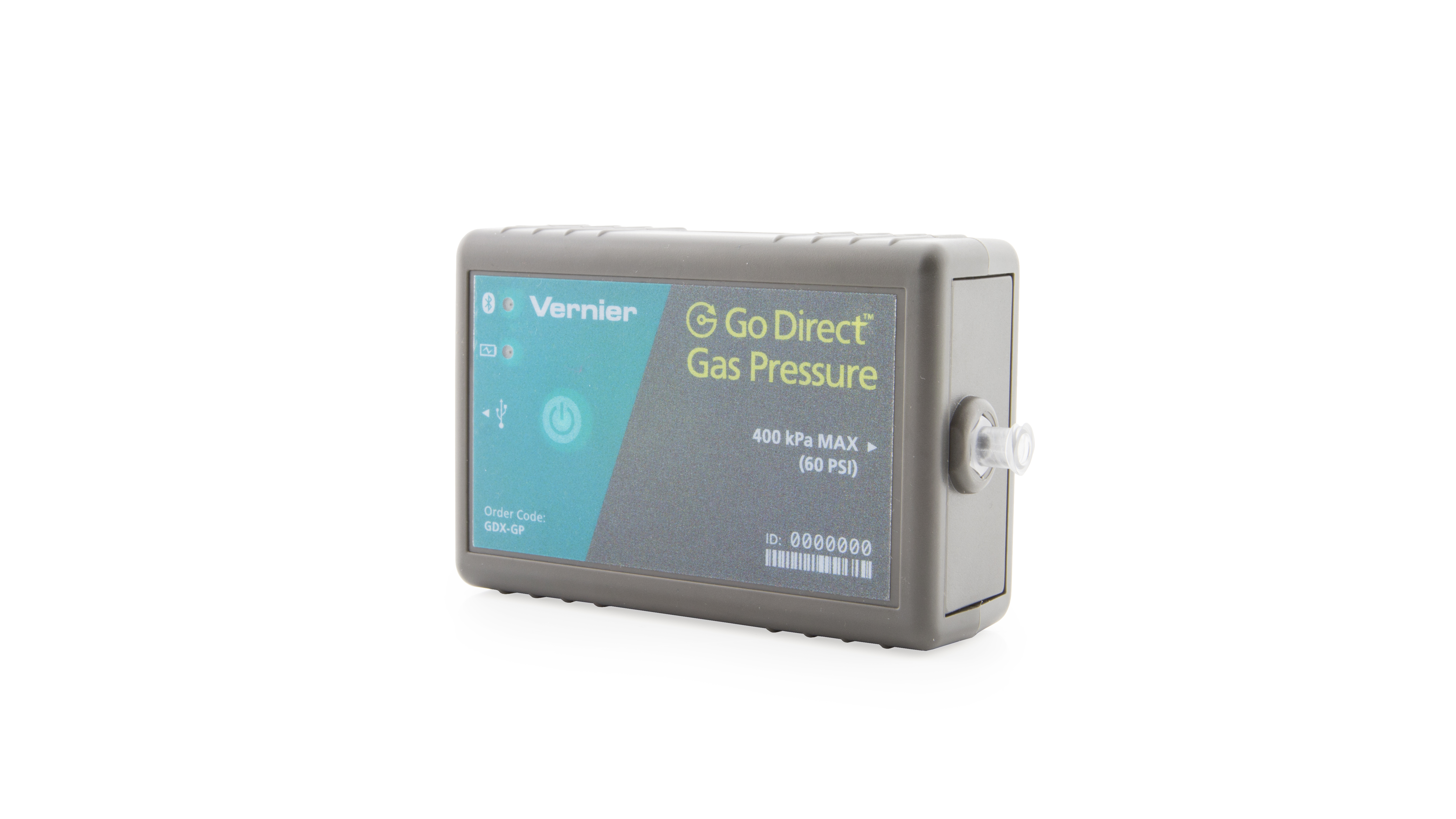
How it Works
The sensor has a flexible membrane that reacts when the pressure changes and is arranged to measure absolute pressure. One side of the membrane is vacuum-like and the other side is open to the atmosphere. Hence, a pressure change is detected and the sensor produces an output voltage that is transmitted to the “Graphical Analysis™ 4 app,” which results in a graphic. The following video shows how to set-up the device:
Video Link:
Key Features
1.Data Collection
• Collect data from multiple sensors simultaneously, either with a multiple-channel interface such as LabQuest Stream or by using multiple Go Direct sensors. Use Data Sharing to retrieve data from just about every Vernier sensor.
• Select time-based or event-based data collection, including events with entry.
• Adjust data-collection rate and duration as needed.
• Trigger time-based data collection on sensor values
• Calibrate sensors, although most of the time this is not needed.
• Enter data manually or using the clipboard.
• Change display units on many sensors.
2. Data Analysis
• Display one, two, or three graphs as needed.
• Set the graph scale.
• Select what is graphed on each axis, and select line or point style graphs.
• Calculate descriptive statistics your data.
• Fit lines and curves to some or all of your data.
• Define calculated columns based on sensor columns.
• View data in a table.
• Highlight and read values from a graph.
• Interpolate and extrapolate using graphed data.
3. Data Sharing
• Receive data shared from Lab Quest or a computer running Logger Pro.
4. Data Storage
• Store and retrieve previously shared data collection and analysis sessions.
Screenshot Examples:
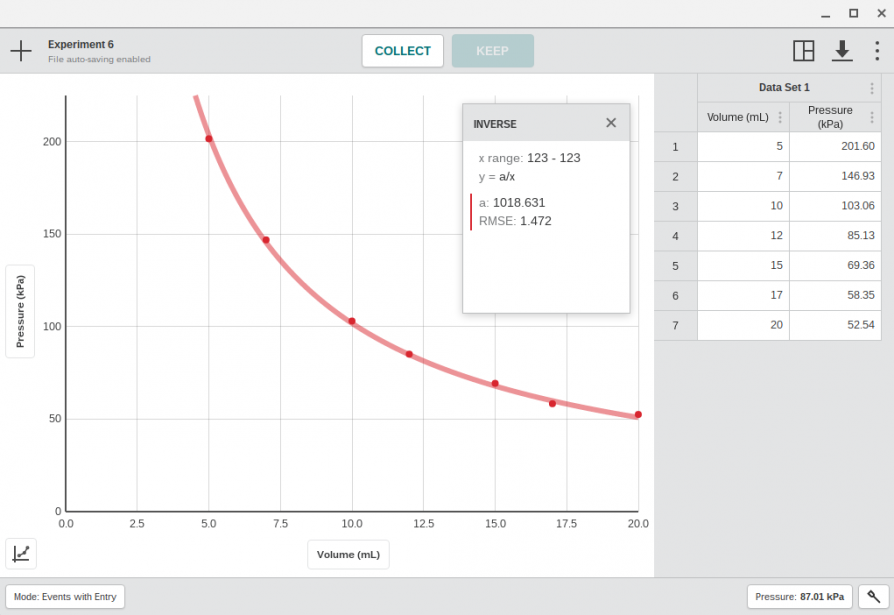
Choose from standard curve fit equations to analyze experimental data. Example: Boyle’s Law
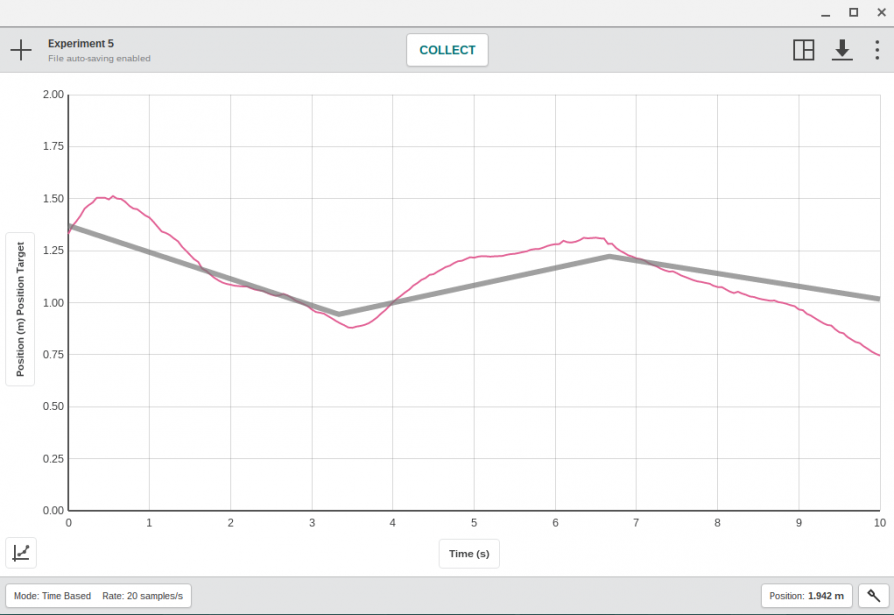
Collect data from multiple sensors simultaneously using two force sensors. Example: Newton’s third law.
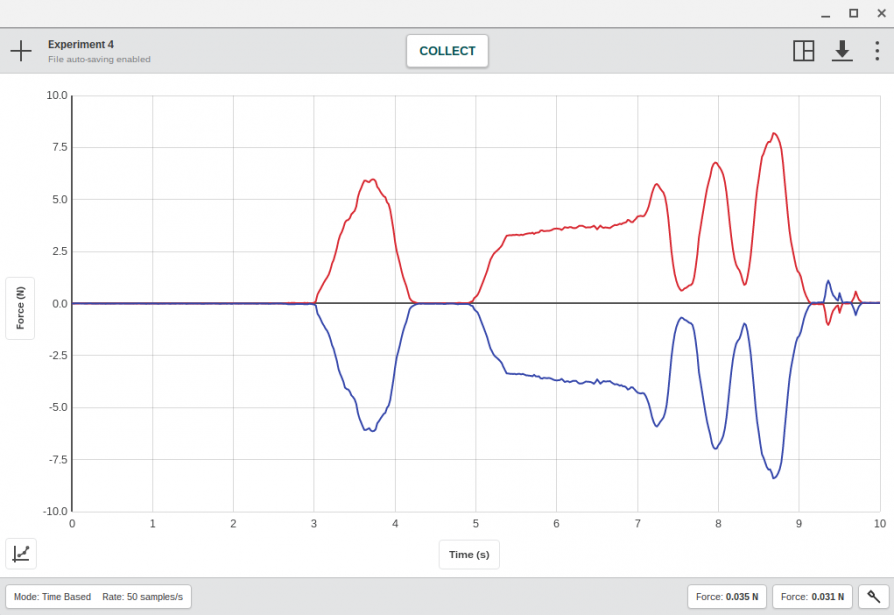
Perform graph math exercises with a motion detector
Requirements for software download
• Windows
Computer running Windows 7 or Windows 10. Only Windows 10 computers with compatible Bluetooth® radios will support Bluetooth connections.
• Mac OS
Computer running Mac OS, USB and Bluetooth.
• Chromebook
Chromebook running Chrome OS 53 or newer. USB and Bluetooth.
• iOS Devices
iOS 9 or newer
iPad (4th generation or newer), iPad mini, iPad Air, and iPad Pro
iPhone (5th or newer)
iPod touch (5th generation or newer)
• Android Devices
Android 4.3 or newer
Tablets: Nexus 7, Nexus 10
Phones: Nexus 5, Samsung Galaxy series, Android devices running 4.1–4.2.2 can download Graphical Analysis v1.2 from Google Play.
The Android version of Graphical Analysis 4 will be available in the first quarter of 2018 with updated system requirements.
Summary
After reviewing the Go Direct® Gas Pressure Sensor, we found it to be a user-friendly device that is an excellent fit for scientific investigations and data collection in both middle-level and secondary classrooms. At $89.00, its cost is reasonable and coupled with the free data analysis software, it is a technology application that we think will enhance scientific inquiry in any science classroom. Undoubtedly, Vernier has a great reputation in the science education community and the Go Direct® Gas Pressure Sensor is another fine example of how Vernier’s excellent products are high quality and help make learning interesting and meaningful for science students!
Cost: $89.00
Edwin P. Christmann is a professor and chairman of the secondary education department and graduate coordinator of the mathematics and science teaching program at Slippery Rock University in Slippery Rock, Pennsylvania. Caitlin Baxter is a graduate student in the mathematics and science teaching program at Slippery Rock University in Slippery Rock, Pennsylvania.
Introduction
The Go Direct Gas Pressure Sensor is used to monitor pressure changes during gas-law experiments. Subsequently, science teachers can use it for graphical analysis and integrate its use in both mathematics and science instruction. In addition, it comes with a free “Graphical Analysis™ 4 app,” which produces real-time graphs from experimental data and is very easy to use.
Using Science and Children: Appreciating editors’ notes
By Peggy Ashbrook
Posted on 2018-02-28
A colleague mentioned that he has a few recent issues of Science and Children to catch up on. Reading an issue of the journal doesn’t have to be front to back. Like preschoolers making a play plan, educators can make a reading plan so a journal can be useful instead of filling up a “to-do” list. As a peer-reviewed journal for teachers, we can count on Science and Children to publish articles sharing effective strategies and workable lesson plans aligned with the Next Generation Science Standards. One colleague likes to tear out the pages that interest her to file for future use as a way to reduce her storage needs. I hold on to the entire issues because it makes it easier to read at the breakfast table, I loan them to colleagues, and I return to the whole issue when I’m revisiting a topic.
 The table of contents states the issue topic (for February, Heredity: Inheritance and variation of traits) and lists each article and Teacher Resource by page number and a brief description. Articles that relate to the issue’s focus are marked with a colored dot. If you are looking for articles about a particular grade level, labels for grades K-3, and grades 3-5, identify the content grade level. Teacher Resources include regularly appearing and occasional columns—the Early Years, the Early Childhood Resources Review, Formative Assessment Probes, Teaching Through Trade Books, The Poetry of Science, Science 101 and 102, Engineering Encounters, Teaching Teachers, Methods and Strategies, Outstanding Science Trade Books for Students K-12, and NSTA Recommends. In every issue: the Editor’s Note. I always read this note because it sets me up with a perspective to ponder as I read the journal, or the parts of the journal I have time for.
The table of contents states the issue topic (for February, Heredity: Inheritance and variation of traits) and lists each article and Teacher Resource by page number and a brief description. Articles that relate to the issue’s focus are marked with a colored dot. If you are looking for articles about a particular grade level, labels for grades K-3, and grades 3-5, identify the content grade level. Teacher Resources include regularly appearing and occasional columns—the Early Years, the Early Childhood Resources Review, Formative Assessment Probes, Teaching Through Trade Books, The Poetry of Science, Science 101 and 102, Engineering Encounters, Teaching Teachers, Methods and Strategies, Outstanding Science Trade Books for Students K-12, and NSTA Recommends. In every issue: the Editor’s Note. I always read this note because it sets me up with a perspective to ponder as I read the journal, or the parts of the journal I have time for.
 Consider this quote from the January 2018 Editor’s Note: Removing Barriers, from Science and Children’s Field Editor, Linda Froschauer: “Science is for ALL. Not just students who are highly capable physically and mentally. Meeting the needs of the entire population is what we do. Remove as many barriers as possible, make learning accessible, and support students as they find their strengths to build on.”
Consider this quote from the January 2018 Editor’s Note: Removing Barriers, from Science and Children’s Field Editor, Linda Froschauer: “Science is for ALL. Not just students who are highly capable physically and mentally. Meeting the needs of the entire population is what we do. Remove as many barriers as possible, make learning accessible, and support students as they find their strengths to build on.”
I appreciate the way the NSTA journal editors, writers, and staff make Science and Children accessible and expand the learning through links to online content. Look for the sciLINKs icon in each issue for web links to accurate, age-appropriate content and pedagogy, the caution symbol, and the vintage film camera icon indicating video in the digital edition of the journal, and a “NSTA Connection” box at the end of some pieces indicating additional information available online.
Look for the “Call for Papers” in the print journal or online and consider sharing your teaching practice with others!
A colleague mentioned that he has a few recent issues of Science and Children to catch up on. Reading an issue of the journal doesn’t have to be front to back. Like preschoolers making a play plan, educators can make a reading plan so a journal can be useful instead of filling up a “to-do” list.
Evolving 'Controversy' in School
By Gabe Kraljevic
Posted on 2018-02-26
 I was considering sending a general email to our staff after learning a few teachers are telling students that evolution is wrong. At the very least I would like for my colleagues to be benign and not detrimental. What are your thoughts?
I was considering sending a general email to our staff after learning a few teachers are telling students that evolution is wrong. At the very least I would like for my colleagues to be benign and not detrimental. What are your thoughts?
– G., Ohio
I think it would be a bad idea to send out a general email. You have to work with your colleagues and airing this out publicly would not be good for relations. Remember, only a few are involved.
Do you know if those staff members who don’t believe in evolution are telling your students to answer questions differently than what you teach? That would be a problem. If they are just stating their opinions then consider if there are larger implications. Depending on your district’s policies, you may be required to talk to the colleagues involved face-to-face as the first step. I recommend that you should talk to them. Remember: You are not trying to change their minds, so don’t argue about evolution. Focus on their effect on your curriculum.
The nature of science focuses on explanations that adhere to evidence. Evolution is a major unifying concept in science. You will teach it and expect your students to understand it, regardless of whether they believe it or not.
You may want to read over NSTA’s position statement on teaching evolution: https://goo.gl/uADYyw
Hope this helps!
Photo credit: J. Cameron [Public domain]
 I was considering sending a general email to our staff after learning a few teachers are telling students that evolution is wrong. At the very least I would like for my colleagues to be benign and not detrimental. What are your thoughts?
I was considering sending a general email to our staff after learning a few teachers are telling students that evolution is wrong. At the very least I would like for my colleagues to be benign and not detrimental. What are your thoughts?
– G., Ohio
Ed News: All About STEM High Schools
By Kate Falk
Posted on 2018-02-23

This week in education news, California state analysts aren’t happy about the governor’s plan to allocate $10 million to set up a new online “intersegmental” higher education initiative; some economics departments are changing the formal classification of their programs so that international students have more opportunities to work in the U.S.; NSTA unveils new book geared toward teachers of 3- to 7- year-olds; after-school programs level the playing field; and Idaho Senate Education Committee votes to approve revised school science standards.
What is a STEM school? It used to mean there were a few more science and math classes. These days, the best STEM schools engage students in real engineering and design challenges and connect them with career opportunities. Some STEM schools, with the help of employers, focus on specific job clusters. Others take advantage of community assets like a college, employer or a zoo. Read the article featured in Education Week.
Online Initiative Not The Answer to STEM Gaps In California
A proposed budget by California’s governor would allocate $10 million to set up a new online “intersegmental” higher education initiative. The project would fund competitive grants for intersegmental teams of faculty to create new and redesign existing STEM courses — both online and hybrid — in a program titled the “California Education Learning Lab.” However, state analysts aren’t keen on the idea. Read the article featured in Campus Technology.
Some economics departments are changing the formal classification of their programs so that international students have more opportunities to work in the U.S. after they graduate. It may seem like the most bureaucratic of changes, but changing the formal classification — what’s known as the federal CIP code — for an economics program from the one for “economics, general” to the one for “econometrics and quantitative economics” means that international graduates of those programs can work in the U.S. for two extra years after they graduate while staying on their student visas. That’s because the Department of Homeland Security considers econometrics and quantitative economics — but not general economics — to be a STEM field. Read the article featured in Inside Higher Ed.
Computer Science for All: Can Schools Pull It Off?
Alante Klyce wants to be a dancer. Yet here she is, inside a sun-filled classroom at Lindblom Math & Science Academy on the city’s South Side, throwing around tech-industry terms like “ideation” and working with friends to design her first mobile app. It’s all part of the introductory computer-science course that every student in Chicago must now take in order to graduate. “I’m still not really that into technology,” said Klyce, 15. “But this is actually my favorite class now.” Read the article featured in Education Week.
Teachers Group Looks To Develop Future Scientists With Book For Preschoolers
NSTA recently unveiled its latest book, and the audience it was developed for may surprise you. A Head Start on Life Science: Encouraging a Sense of Wonder is geared toward teachers of 3- to 7- year-olds and offers 24 inquiry-based lessons, which are designed to develop a sense of curiosity about the world within preschoolers. Read the article featured in Associations Now.
What Does Growth Look Like for a Student Who Isn’t Having Success on Standardized Tests?
Over the course of my career, I’ve had some years where my students’ standardized test scores were on the rise, and other years where they stagnated. Rarely did these scores correlate to the amount of growth each learner had experienced during our time working together. One thing I know to be true is that little things matter a lot when it comes to recognizing student growth. Read the article featured in EdSurge.
After-School Programs Level The Playing Field
For many educators, this is a time of confusion and frustration as we watch continued attacks on federal funding for education — including after-school programming. We watched with concern earlier this year as the Trump Administration shortsightedly sought to eliminate funding for the 21st Century Community Learning Centers program for fiscal year 2018. Read the article featured in EdSource.
What Is Innovation In Early Education And Why Is It Crucial?
The term “innovation” can conjure images of Silicon Valley, product pitches, dramatically new ideas for solving problems, and, ultimately, disrupting the status quo. What can be more challenging, though, is to think about this notion of innovation in the context of fields where advancement largely depends upon building capacity among adults, to improve relationships and interactions among people. Take, for example, the field of early education, where improving teaching and care practices are a linchpin to improving quality. Read the article featured in Education DIVE.
Senate Panel’s Vote Gives Idaho Schools New Science Standards, Climate Change And All
After three years of resistance at the GOP-dominated Idaho Statehouse, including more pushback from House Republicans this session, the Senate Education Committee voted 6-3 on Thursday to approve revised school science standards as-is – with no parts relating to climate change deleted. Read the article featured in the Idaho Statesman.
Why Arming Teachers Is Highly Unlikely
President Donald Trump said Wednesday that the White House is “very strongly” considering the possibility of arming teachers and other school staff following the deadly Florida school shooting — but the reality is that won’t happen any time soon, even in states that would allow guns in schools. Read the article featured in POLITICO.
Stay tuned for next week’s top education news stories.
The Communication, Legislative & Public Affairs (CLPA) team strives to keep NSTA members, teachers, science education leaders, and the general public informed about NSTA programs, products, and services and key science education issues and legislation. In the association’s role as the national voice for science education, its CLPA team actively promotes NSTA’s positions on science education issues and communicates key NSTA messages to essential audiences.
The mission of NSTA is to promote excellence and innovation in science teaching and learning for all.
Follow NSTA

Choosing Instructional Materials: Lessons Learned
By Cindy Workosky
Posted on 2018-02-23
Throughout my career as an educator, I’ve had many opportunities to select instructional materials. One experience is particularly memorable because I learned then that how you select instructional materials can be as important as what materials are selected.
By that point in my career, I had selected materials for other content areas, but I had been the only teacher making the choices, and the process was simple: Pick the text I like most, and submit it to the district.
This time, however, the process was a bit more complicated because I was part of a team making the selection. The biology team reluctantly gathered our sub lesson plans and headed to the district office. Using the district’s evaluation criteria, we spent all day reading and evaluating stacks of sample materials. By the end of the day, we narrowed our selections down to two options.
The first option was not surprising: It was the newer version of what we were currently using, and we were ecstatic about the resources that would be at our fingertips. Every page was filled with great photos, graphics, and icons, along with thoughtfully formatted text on glossy pages; technology supports were integrated throughout; accompanying video clips were provided; lab books and student worksheets were coordinated with the student text; and a tall stack of fancy color transparencies (yes, this was a few years ago) were at our disposal. These resources and more were coordinated with an equally glossy wraparound teacher’s edition.
The second option seemed much less desirable. It lacked DVDs; provided only a few color transparencies; included neither links to additional online information, nor glossy visuals; and had fewer hints and tips embedded on the pages. In addition, the teacher’s guide was a separate volume with little except text to support instruction.
You might be wondering why we would choose this textbook as a finalist when it was so obviously lacking the resources the first one offered. We did so because the district’s review process challenged us to closely examine our choices. When we did, we realized that the second book was organized in a way that better aligned with the type of teaching we were striving for—one that supported students in making sense of the world around them, rather than just memorizing increasingly complex scientific information. It was less flashy, but more relevant to students.
Publisher sales pitches we heard the following month reaffirmed our thoughts and we chose the second text. Because my district had a process and criteria that allowed us to focus on what mattered most while giving us the autonomy to make a wise decision, we were able to select the materials that would help us improve our instruction.
If we hadn’t undertaken a facilitated, criterion-based review, we would have ended up with the same type of materials as before and experienced the same frustrations in the classroom. The selection process helped us identify what we really needed to change in the classroom and motivated us to make the right choice to achieve those goals. Additionally, because we came to this realization through the process rather than having it imposed on us, we owned the implementation of the materials and used it as an opportunity to advance instruction in our classrooms.
This experience was a watershed moment for me because it helped me understand that a robust process for selecting instructional materials can pay significant dividends over time.
Based on my experiences in the classroom, at the state level, and now at Achieve, I have five big lessons that I’ve learned about selecting instructional materials. Many of you are seeking instructional materials that are truly designed for teaching the NGSS, materials that don’t just have an alignment sticker or use the NGSS colors. You want materials that will make your classroom one in which students develop and use all three dimensions of the standards to make sense of phenomena and design solutions to problems. As you evaluate materials and make selections, keep these lessons learned in mind:
- Selecting instructional materials should be a part of a broader implementation plan. Materials are key, but can’t do everything and they’ll have a bigger impact if they are embedded in a larger initiative. If you don’t know where to start, check out these state and district implementation resources.
- Don’t do it alone. It’s helpful to have other local educators to work with, but for those in rural areas with few science colleagues, or those struggling to find willing colleagues, communities on Twitter, Facebook, and in the NSTA Learning Center can serve as a sounding board for ideas and a source of support and feedback.
- Be clear on what you need. It’s a common mistake to think that materials are the first step to implementation, but if you don’t know what materials designed for teaching the NGSS look like, you might select ones that appear to be aligned, but aren’t. Check out the criteria and support in the NGSS Lesson Screener (for lessons), the EQuIP Rubric for Science (for units), and PEEC (for year-long materials) here. In particular, read about the NGSS Innovations in PEEC that highlight what is new in these standards and how instructional materials can reflect that. Many producers of materials are making claims about NGSS alignment. Be skeptical consumers.
- Try out a unit designed for the NGSS in your classroom. To determine and understand the types of materials you’ll need, try a few in your classroom to decide what support is most helpful. You can find a variety of units identified as quality units designed for the NGSS here, and more are being posted regularly.
- Understand the power of the process. Develop a selection process that brings teachers together to build a common understanding of what good materials are, and use carefully selected criteria to analyze the materials You’ll ultimately choose the materials best suited for your students, and teachers will be better prepared to implement them.
While high-quality materials are needed, that’s only one of the factors to consider. The materials need to be part of a broader science implementation plan that includes, among other things, professional learning to support ongoing improvement in instruction. But how these materials are selected can help address several implementation issues simultaneously if it is done well. Because this is likely the most significant science-specific expenditure your district will make, it’s worth devoting the time and resources needed to select materials in a thoughtful, strategic way. Use this process as a lever for change to improve science instruction for every student in your district.
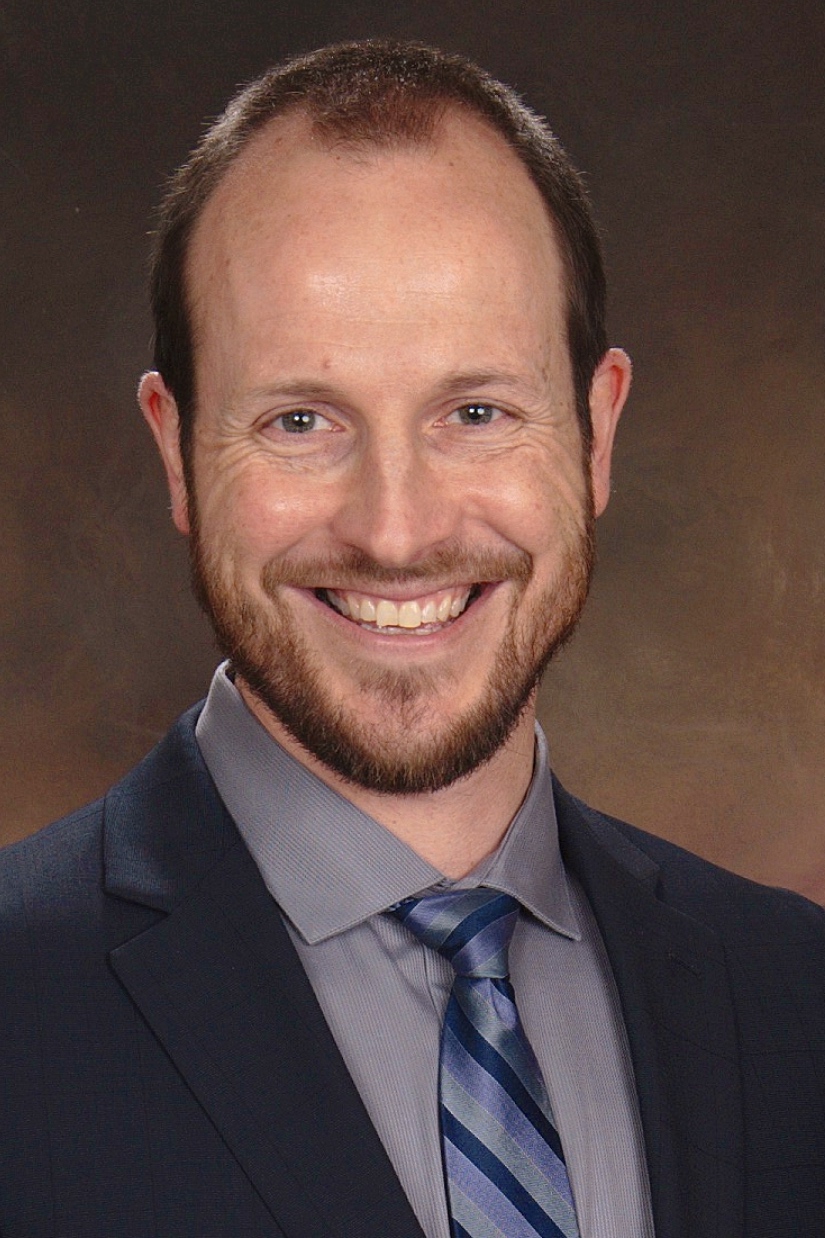
Matt Krehbiel
Matt Krehbiel is the Science Director at Achieve, Inc. Reach him at mkrehbiel@achieve.org and follow him on twitter at @ksscienceguy. Come learn more about selecting instructional materials designed for the NGSS during his session at the NSTA National Conference in Atlanta. The session, Looking for NGSS-Focused Instructional Materials?, is part of the day-long NGSS@NSTA Forum focused on instructional materials.
This article was featured in the February issue of Next Gen Navigator, a monthly e-newsletter from NSTA delivering information, insights, resources, and professional learning opportunities for science educators by science educators on the Next Generation Science Standards and three-dimensional instruction. Click here to sign up to receive the Navigator every month.
Visit NSTA’s NGSS@NSTA Hub for hundreds of vetted classroom resources, professional learning opportunities, publications, ebooks and more; connect with your teacher colleagues on the NGSS listservs (members can sign up here); and join us for discussions around NGSS at an upcoming conference.
The mission of NSTA is to promote excellence and innovation in science teaching and learning for all.
2018 National Conference
NGSS Workshops
2018 STEM Forum & Expo, hosted by NSTA
2018 Area Conferences
Follow NSTA
Throughout my career as an educator, I’ve had many opportunities to select instructional materials. One experience is particularly memorable because I learned then that how you select instructional materials can be as important as what materials are selected.
By that point in my career, I had selected materials for other content areas, but I had been the only teacher making the choices, and the process was simple: Pick the text I like most, and submit it to the district.



